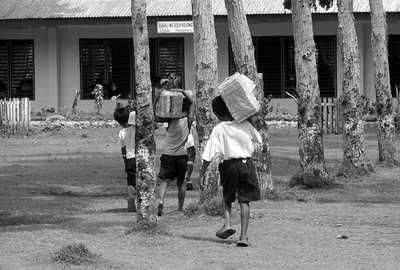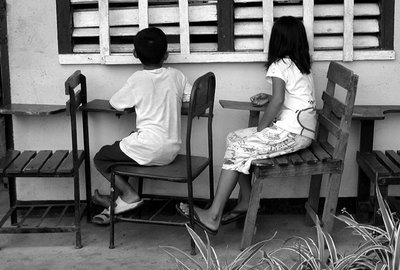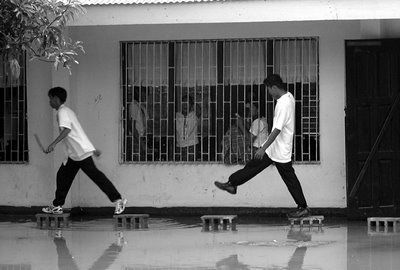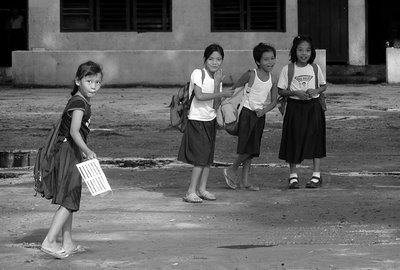
Thirst for knowledge
Learning in an underprivileged world ©2004
A non-government organization has reported back in 2004 that the Philippine public education system is in crisis. It said that only six out of every 1,000 grade six elementary graduate students are prepared to enter high school. Only two out of every 100 fourth year high school students are fit to enter college. Only 19 out of every 100 public school teachers have confidence and competence to teach English. It went on to say that the Philippines is second to the last among 38 countries in science and mathematics.
And since it is in a crisis, the Philippine public school system is in dire distress and needs all the help it can get to get out of the quagmire it had slowly sunk into. In the same report, the Kaakbay-CDI cited that one in every eight schools has a teacher-to-pupil ratio of 1:50 and above. One in every seven students does not have a classroom. One in every five students does not have a desk. One in every three students does not have a single textbook. Two to eight students share in a single set of textbooks.

The quality of Philippine education is declining continuously. Elementary and high schools are failing to teach the competence the average citizen needs to become responsible, productive and self-fulfilling.

The principal reasons for this decline are: 1) the country is simply not investing enough in the education system, and 2) the education establishment has been poorly managed.

The rural areas and the countryside are the worst affected areas of the deteriorating quality of public education in the Philippines.

The Kaakbay sa Pag-aaral Capacity Building for Rural Learning and Development Project of the group in its framework, wants to help the education officials arrest and reverse the deterioration of the Philippine public education.

Kaakbay sa Pag-aaral is the response of the Katipunan ng mga Anak ng Bayan-Citizens’ Development Initiatives, Inc. (Kaakbay-CDI) to the call of the Department of Education to assist responsibly in nation-building by sharing in the challenging task of delivering quality education under its “Adopt-A-School Program.”

So, after little convincing by the NGO in October and November 2004, I accepted the invitation to document in photographs a noble endeavor of providing textbooks to students in several depressed public schools in the country.

Kaakbay is a non-profit, non-stock entity that has for several years empowered communities to be socially responsible. This time, however, the focus was no longer in community development work, but has shifted on a campaign to seek potential international and local donors, to fund for the acquisition of much-needed textbooks for the students in depressed areas.

Photo documenting the nightmarish plight of the public schools in the Philippines is not new to me. I have been documenting it in intervals in the last 25 years – with much emphasis on the province of Bataan and the Mindanao region. This time, it would take me back again to places I have been to before.

Despite the limited timeframe allotted to me to comprehensively photograph the deteriorating public school system in the countryside, I was able to produce scores of images of what I would say has become of our country’s learning system. The candid portraits of rural students taken during these journeys are my testament to what has gone awry of Philippine public schools.

The photographs also showed the glow on the faces of the students as they welcomed the book drive and our arrivals with fanfare and exuberance. For these students, the arrival of the new books was Heaven sent.

To substantiate Kaakbay’s proposals to donor agencies, and to boost the credibility of the organization as the proponent and implementer of the program, it has in its initial step, undertaken pilot projects where more than 500 reference textbooks in each of the pilot elementary and highs schools in Mindanao (Lanao del Sur and Surigao del Norte), Visayas (Samar) and Luzon (Pampanga) had benefited.

Our group consisted of several key figures in the intervention sphere that included Alain Pascua, Kaakbay executive director, myself, and videographer Rene delos Santos, to fully document the book drive and to interview stakeholders. Visual materials and data sheets acquired in these pilot projects have been included in the group’s final project proposal. The final AVP was presented during the launching of the project in early December 2005.


Since the group did not have the necessary funds to implement the project, it has knocked on the doorsteps of charitable organizations to help raise the initial amount of funds to finally jumpstart the project.

The project focused on the following top five to ten percent of the poorest barangays, areas of conflict, 15 areas of constant neglect and insufficient or absent government services because of budget constraints, difficult terrain, unstable peace and order situation, and non-prioritization - places where ignorance, backwardness and poverty thrive.

The Kaakbay program would cover the following: 1) Elementary Schools where basic levels are the foundation of education that must be firmly built.

2) Science, Mathematics and English - Essential subjects where their basic principles define the strength of the foundation of education. The core subjects are Science, Mathematics, English, Filipino and Makabayan. “Makabayan” is the Filipino translation of “Patriotism” and this core subject covers History, Technology and Livelihood Education, Music, Physical Education, and Values. The core subjects English and Filipino includes Reading and Writing.

3) Textbooks, teachers’ manuals, classroom and library materials where basic tools of teaching and learning are much needed. There is actual insufficiency of available materials. Resource backlogs are prevalent in the rural areas. Cost is affordable compared to other needs.

4) Stakeholders’ social mobilization to providing quality education should be a priority responsibility of all sectors of the school and community. Everyone must share in this task. The society has to be awakened. The issue must be brought to the heart of each community.

A secondary priority rationale will also cover 5th to 6th Class Municipalities. In the absence of available data and statistics in the identification of poorest barangays, the list of poorest municipalities will initially suffice until such time the mapping system is designed and working.

Included are public high schools where basic education must be reinforced further. Even without college education, the youth must be well prepared to face the challenges of life.

Subjects would include: Value Formation and Information Technology where competitiveness and preparedness must be undertaken to face the challenges of globalization, after laying down the needed foundations of education.


Services would include teachers’ training where the concept and usage of all new teaching and learning materials must be transferred to teachers to maximize all potentials.

The Project is anchored on establishing partnerships with both international and local institutions in mobilizing needed resources to provide equal opportunities to the country’s poorest rural areas and areas of conflict in order for the pupils, students and teachers in those areas to be at par or equal to their counterparts in urban areas.

The children in the urban areas enjoy greater access to quality education than those of poor families in the rural areas. Aside from having complete textbooks, urban children have access to modernized libraries with complete reference materials, computers, educational materials in various media formats, and internet access. The benefits of urbanization have greatly helped and improved most urban schools, which have become well equipped and modernized in recent years.

In contrast, public schools in rural areas suffer both from lack of teachers, classrooms, textbooks, other educational materials, and having dilapidated school buildings/classrooms. These schools do not have libraries, and if they have, the libraries are underdeveloped and ill-equipped. Computers, educational materials in various media formats, and internet access are alien to both students and teachers.

The Project shall contribute in addressing rural education resource shortages and limited access to quality education and information through capacity building measures.

The Kaakbay sa Pag-aaral Capacity Building for Rural Learning and Development Project shall mobilize and empower local community stakeholders to enable them to upgrade the Public Rural Education System by developing and implementing project components that will respond to the specific needs of public school students, teachers and administrators in poorest rural areas.

The Project has been successfully initiated in 12 Pilot Areas: Luzon – Candaba, Pampanga - 1) Paralaya Elementary School, and 2) Pasig National High School. Mayor Jerry Pelayo provided transportation, accommodation and food. Local Kaakbay-CDI coordination and operations were undertaken by Leny Manalo.

Visayas – Zumarraga Island, Western Samar - 3) Pangdan Primary School, and 4) Zumarraga Integrated School. Congressman Catalino Figueroa and Mayor NelipthaFigueroa raised counterpart funds and provided transportation, accommodation and food.

Visayas – Northern Samar - 5) San Roque Central Elementary School in San Roque, 6) Hibubullao National High School, and 7) San Francisco Elementary School in Catubig, and 8) Las Navas Central Elementary School in Las Navas. Mayors Caesar Vicencio and Arlito Tan raised counterpart funds and provided transportation, accommodation and food. Local Kaakbay-CDI coordination and operations were undertaken by Albert Padro and Isaac Eleuterio Tan.

Mindanao – Siargao Island, Surigao del Norte - 9) Pilar Elementary School in Pilar, and 10) Gen. Luna National High School in Gen. Luna. Mayors Nemer Tesiorna and Cecilia Rusillon raised counterpart funds and provided transportation, accommodation and food. Local Kaakbay-CDI coordination and operations were undertaken by Maritoni Segovia and Sanee Lacson.

Mindanao – Lanao del Sur - 11) Benito Memorial National High School in Maguing, and 12) 77th PC Elementary School in Taraka. Mayors Hakim Abinal and Oding Sumagayan provided transportation, accommodation and food. Local Kaakbay-CDI coordination and operations were undertaken by Hadji Abdulrashid Ding Ladayo.

About 3,000 Student Textbooks, 4,000 Instructional Materials, and 600 Teachers’ Manuals, amounting to less than P1 million have already been distributed in the pilot projects.


In October 25, 2004, when Senator Manuel Villar was still the chairman of Senate Committee on Finance, he said: “The Philippines allots only 3.2% (P111 billion or $2.1 billion) of the country’s gross domestic product (GDP) for education. It is the third lowest compared to other Asian countries: Malaysia 7.9%, Thailand 5%, Hong Kong 4.1%, Japan 3.6%, South Korea 3.6%, China 2.2% and Indonesia 1.3%. Even as a percentage of the national budget, at 14% the Philippines ranks the third lowest in Asia. Debt service payments have soared from only 8.1% of the GDP in 1990 to 19% in 2004, while the increase in education spending is minimal, from 2.9% in 1990 to 3.2% in 2004.”


Former education secretary Edilberto de Jesus, in a February 2003 message stated on a Adopt-A-School Program School Adoption kit, he said: “Government cannot and should not shoulder on its own the task of delivering quality education. For this reason, the Department pushed for the full implementation of the Adopt-A-School Program to give the private sector an avenue to provide additional resources to our public education system.”


In his speech at the 24th National Educators Congress, 18 October 2004, in Bacolod City, Abad said: “There is a crisis in Philippine education. Only 0.64% of some 1.4 million Grade VI students got a score of 75% and above in the 2004 High School Readiness Test (HSRT). The mean percentage score was 32.13%.”

The January 2001 to June 2004 performance report of the Department of Education which was released on October 12, 2004, stated on Page 7 that, “The delivery of basic education has been confronted by the ill effects of continuing, rapid population growth and the dwindling Philippine economy. Public school enrolment… consistently expanded, while government’s spending for basic education has not kept pace with such increases.”
Two years have passed since the book drive begun but nothing seemed to have been done on the part of the government to really uplift the public education system in the Philippines. It would be good indeed if only government officials would be serious on their promises to instill positive changes in the public education system. If only more money is spent to upgrade public school infrastructures, student learning aids, and teachers' training modules, rather than squander so much money on the military, maybe changes will take effect. Once this is realized, perhaps learning in an underprivileged world would then have a meaningful effect on the country's impoverished students.
___________________________________________________________
Outtakes
It was like separating the chaff from the grain. Editing images in documentaries is painstaking than editing images for news and features. Of the thousands of images taken during the Kaakbay book drive, of which I have chosen more than three hundred images for final lightbox selection, I have chosen 40-something images to run with the story. They were chosen not because of their relevance to the theme, but because the images reflect the character of the subjects as they react infront of the lens. However, without having to share to the bloggers the rest of the images, the story would be deemed incomplete because other interesting images in the outtakes would have been left in limbo in the dark and deep crevices of the computer hard drive.
I originally planned to present the documentary in beta format but I have not yet upgraded my blogsite to beta blog so in the meantime, I decided to post the images as outtakes. By doing this, viewers, particularly those taking up a serious course in photojournalism, will have an understanding on how documentary image editing is applied. You may also wonder why documentaries have more images than the regular essays and features. I will not delve on it at the moment, but will one day share with you more of my thoughts on this aspect.
The Thirst for knowledge images above, and the Outtakes below had been left unlabeled (no captions).



























































0 Comments:
Post a Comment
<< Home